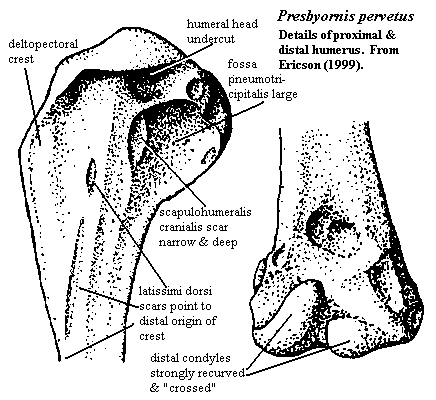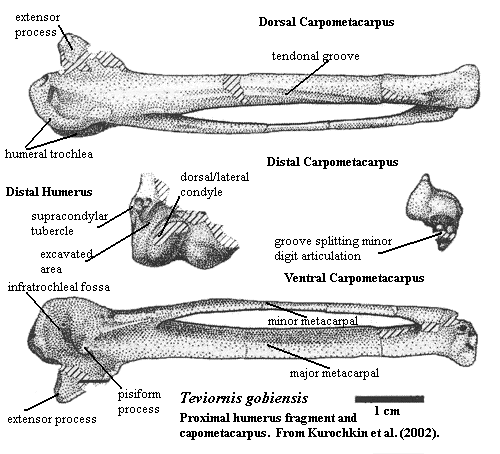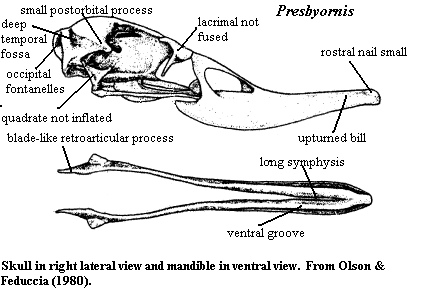 Anatoidea: ducks, swans, most geese & close relatives).
Anatoidea: ducks, swans, most geese & close relatives).| Galloanserae | ||
| The Vertebrates | Anatoidea |
| Vertebrates Home | Vertebrate | Vertebrate |
|
Abbreviated Dendrogram
Aves
├─Gruimorpha
└─Galloanserae
├─Galliformes
│ ├─Megapodidae
│ └─┬─Numididae
│ └─Phasianidae
├─Anseriformes
│ ├─Anhimidae
│ └─Anseres
│ ├─Anseranas
│ └─Anatoidea
│ ├─Presbyornithidae
│ │ ├─Teviornis
│ │ └─┬─Presbyornis
│ │ └─Telmabates
│ └─Anatidae
│ ├─Anserinae
│ └─Anatinae
└─Charadriomorpha
|
Contents
Overview |
Feduccia [F99] has described Presbyornis as a bird with the body of a flamingo and the head of a duck. Stripped of any phylogenetic implications, the statement is a fair one. Indeed, it may yet have some phylogenetic basis, although this now seems unlikely [H02]. As we have already written much on Presbyornis, we will say only a little more.
The Presbyornithids were a remarkably successful bunch, easily the most common family in the fossil record of birds for over 20 My, from the latest Cretaceous to the Middle Eocene. This does nor necessarily mean that they were as common on the ground as they are in it. Presbyornithids congregated in large groups near quiet inland waters -- good conditions for preservation. Yet they cannot have been rare. Flamingos, which are very similar in anatomy and lifestyle, are found much less frequently.
From the few scraps of bone available to us, the family seems to have evolved in the Campanian or early Maastrichtian, remaining anatomically quite stable after that point. Presbyornis must surely have been startlingly different from anything else we know of in the Late Cretaceous. This is probably due to our deep ignorance of the avifauna of this time [H02]. However, it is easy to see how a medium-sized, strongly colonial bird with a tolerance for brackish waters could take advantage of the slowly draining inland seas of North America and the drying lake systems of East Asia. They disappear only with the rising seas and unstable climates of the Late Eocene. ATW030322.
References: Feduccia (1999) [F99]; Hope (2002) [H02].
 Anatoidea: ducks, swans, most geese & close relatives).
Anatoidea: ducks, swans, most geese & close relatives).
From the Late Cretaceous (Maastrichtian).
Anseres :: Anatalavis + * : Presbyornithidae + (Cnemiornis + Anatidae)
Characters: premaxillary symphysis rounded, not pointed [L97*]; costal ribs, pneumatic foramina absent from dorsal part of medial face [L97*]; sternum, pneumatic pores absent from the middle part of the internal surface reversal) [L97*]; hypocleideum absent (reversal) [L97*]; scapula, acromion process, straight & slightly flared [H02]; scapula, acromion process long [H02]; coracoid, pneumatic foramen absent from base of procoracoid process (compare image at Anatalavis) [L97*]; coracoid, supracoracoideus sulcus, ventral margin stout & columnar, becoming broader toward clavicular facet [H02]; coracoid, supracoracoideus sulcus with large included central depression [H02]; coracoid, clavicular facet undercut or invaded ventrally [H02]; coracoid, pneumatic foramen absent from distal (sternal) extremity reversal: compare image at Anatalavis) [L97*]; tarsometatarsus, hypotarsus not laterally displaced (reversal) [L97*]; tarsometatarsus, trochlea for MtII not as distal as trochlea for Mt IV (see image at hypotarsus) [L97*]; hallux short (reversal) [L97*].
Notes: [1] The notation "[L97*]" indicates a synapomorphy based on the osteological dataset of [L97] run under PHYLIP with all characters unordered.
References: Hope (2002) [H02]; Livezey (1997) [L97].
Range: Late Cretaceous (Maastrichtian) to Late Eocene of Asia, North America, South America & Antarctica.
Phylogeny: Anatoidea : (Cnemiornis + Anatidae) + * : Teviornis + (Presbyornis + Telmabates).
Characters: frontal narrow, with edges smoothly rounded [E97]; lacrimals not completely fused into nasofrontal region [E97]; jugal process of maxilla ventral to maxillopalatines [E97]; postorbital process of squamosal excavated ventrally [E97]; quadrate with maxillary process not inflated posterior to quadratojugal articulation [E97]; occipital fontanelles present [E97]; palate with rostropterygoid articulation [E97]; mandible with deep groove on ventral surface of anterior part [E97]; recessus conicalis present [O99]; all thoracic vertebrae amphicoelous [E97]; thoracic vertebrae with large lateral pleurocoels [E97] [E99]; first synsacral vertebra with centrum markedly more laterally compressed than succeeding centra [E97]; median apical crest of sternum absent [H02]; sternum with two stout, strongly asymmetrical crests separated by sulcus [1] [H02]; sternum with overlapping coracoid facets in some specimens [H02]; scapula, humeral facet, distal end protruding and slightly flared [H02]; scapula, part of humeral facet distally attenuated to a point [H02]; scapula with acromion process pointed and protruding anteriorly [E97]; scapula with long, ragged scar for m. serratus superficialis on ventral (internal) face just distal to humeral facet [2] [H02]; coracoid with striated muscle scars on dorsal surface [E97]; coracoid, clavicular facet undercut ventrally by small cavity [H02]; coracoid, humeral facet large, flat, & ovate (compared with other anseriforms) [H02]; coracoid, scapular facet somewhat larger, rounder & closer to humeral  facet (compared to other anseriforms) [H02]; humeral head undercut [E99]; proximal humerus with scar for m. scapulohumeralis cranialis deep & narrow [E99]; proximal humerus with fossa pneumotricipitalis ventralis large and relatively deep [E99]; proximal humerus with line of scars for latissimi dorsi "pointing" to distal origin of deltopectoral crest [E99]; humeral shaft very long [H02]; distal end of humerus strongly "tilted" (?!) with condyles recurved [H02]; recurvature of distal humeral condyles so extreme that the lateral condyle "crosses" the medial condyle (see image) [H02]; ulnare with shallow sulcus on lateral (?!) face [K+02]; ulnare with wide metacarpal notch [K+02]; radiale thinner/flatter posteriorly (towards ulnare) [K+02]; radiale deeply excavated on dorsal side [E99]; radiale with deep proximal sulcus just posterior to pronounced central tubercle [K+02]; carpometacarpus with dorsal half of proximal trochlea as long or longer than ventral half [E97]; carpometacarpus straight, with parallel major & minor metacarpals [K+02]; carpometacarpus extensor process, proximal edge curved (exception: vertical in Teviornis) [K+02]; carpometacarpus dorsal ridge of carpal trochlea well developed & connected to the dorsal emargination of the metacarpal of the major digit [K+02]; carpometacarpus with "small canalis interosseus distalis" in infratrochlear fossa [K+02]; carpometacarpus with well-developed scars for dorsal ligaments from the ulna and radius [K+02]; carpometacarpus with dorsal tendonal sulcus extending at least 1/3 (actually ~2/3) total length [K+02]; major digit, pahalanx 1 with two dorsal depressions [K+02]; major digit, pahalanx 1, proximal face with blunt, anteroventrally protruding tubercle [K+02]; tibiotarsus with opening of extensor canal approximately midway between lateral & medial condyles at distal end (see image at supratendinal bridge) [E97]; tarsometatarsus with medial crista very low [E99].
facet (compared to other anseriforms) [H02]; humeral head undercut [E99]; proximal humerus with scar for m. scapulohumeralis cranialis deep & narrow [E99]; proximal humerus with fossa pneumotricipitalis ventralis large and relatively deep [E99]; proximal humerus with line of scars for latissimi dorsi "pointing" to distal origin of deltopectoral crest [E99]; humeral shaft very long [H02]; distal end of humerus strongly "tilted" (?!) with condyles recurved [H02]; recurvature of distal humeral condyles so extreme that the lateral condyle "crosses" the medial condyle (see image) [H02]; ulnare with shallow sulcus on lateral (?!) face [K+02]; ulnare with wide metacarpal notch [K+02]; radiale thinner/flatter posteriorly (towards ulnare) [K+02]; radiale deeply excavated on dorsal side [E99]; radiale with deep proximal sulcus just posterior to pronounced central tubercle [K+02]; carpometacarpus with dorsal half of proximal trochlea as long or longer than ventral half [E97]; carpometacarpus straight, with parallel major & minor metacarpals [K+02]; carpometacarpus extensor process, proximal edge curved (exception: vertical in Teviornis) [K+02]; carpometacarpus dorsal ridge of carpal trochlea well developed & connected to the dorsal emargination of the metacarpal of the major digit [K+02]; carpometacarpus with "small canalis interosseus distalis" in infratrochlear fossa [K+02]; carpometacarpus with well-developed scars for dorsal ligaments from the ulna and radius [K+02]; carpometacarpus with dorsal tendonal sulcus extending at least 1/3 (actually ~2/3) total length [K+02]; major digit, pahalanx 1 with two dorsal depressions [K+02]; major digit, pahalanx 1, proximal face with blunt, anteroventrally protruding tubercle [K+02]; tibiotarsus with opening of extensor canal approximately midway between lateral & medial condyles at distal end (see image at supratendinal bridge) [E97]; tarsometatarsus with medial crista very low [E99].
Note: [1] I don't quite follow the description here, even with the help of Hope's excellent photographs. However, one of the crests seems to merge with the carina while the other simply peters out. [2] On the image at left, that would be just below the humeral facet and on the hidden, reverse face of the bone. This muscle is apparently the same as the serratus anterior. It attaches to the sternal ribs ventrally and expands the chest to aid in respiration.
Links: BIRD STUFF AND CLADISTICS; New Mesozoic bird papers in AMNH Novitates; Mesozoic Neornithes; Abstracts for PaleoBios 20(1-3); 75th Abstracts -- Abstract 34; PalAss Annual Conference Abstracts 2000; Presbyornithidae (Mikko's Phylogeny); A MIDDLE EOCENE SHOREBIRD FROM CHINA Un Ave Playera de China del ...;
References: Ericson (1997) [E97]; Ericson (1999) [E99]; Hope (2002) [H02], Kurochkin et al. 2002) [K+02]; Olson (1999) [O99]. ATW030307.
 Teviornis: T. gobiensis Kurochkin et al. 2002.
Teviornis: T. gobiensis Kurochkin et al. 2002.
Range: Late Cretaceous (early Maastrichtian) of Mongolia (Nemegt fm).
Phylogeny: Presbyornithidae : (Presbyornis + Telmabates) + *.
Characters: humerus with dorsal supracondylar tubercle extended far proximally [K+02] [1]; humerus with well-excavated fossa between lateral (=dorsal) condyle & supracondylar tubercle [K+02] [2]; carpometacarpus, humeral trochlea, dorsal & ventral processes extend equally far anteriorly [K+02]; carpometacarpus with infratrochlear fossa stretched anteroposteriorly [K+02]; carpometacarpus with pronounced muscle scars & excavations in infratrochlear fossa [K+02]; carpometacarpus extensor process arises almost vertically above trochlea [K+02]; carpometacarpus, pisiform process on same anteroposterior level as major metacarpal [K+02]; carpometacarpus, area anterior to pisiform process "somewhat excavated" [K+02]; carpometacarpus with minor digit metacarpal much thicker proximally than distally, both dorsoventrally & anteroposteriorly [K+02]; carpometacarpus, articular facet for minor digit split by anteroposterior groove into 2 distinct articular surfaces [K+02]; manus, major digit, phalanx 1 with distal extension of metacarpal articulation broadened distally [K+02]; major digit, pahalanx 1 with straight anterior edge in dorsal view [K+02].
Notes: [1] this is supposed to differentiate Teviornis from Presbyornis. In fact, the supracondylar tubercle appears almost identical to that of P. pervetus illustrated above under Presbyornithidae. On the other hand (well, actually on both hands) the humeral condyles appear to have a significantly different shape and curvature. The Teviornis medial condyle is larger, extends further proximally and is not "crossed" by the lateral condyle to nearly the same extent as in P. pervetus. Could this be what was intended? Kurochkin et al. attempt to use the Latinized nomenclature of the Nomina Anatomica Avium but make numerous errors of Latin grammar and spelling. Perhaps the authors intended the word tuberculum to refer to the medial condyle itself? [2] This, also, appears identical to Presbyornis as illustrated in Ericson (1999) and Hope 2002).
Links: New Mesozoic bird papers in AMNH Novitates; Mesozoic Neornithes.
References: Kurochkin et al. (2002) [K+02]. ATW030313.
 Presbyornis: P. pervetus Wetmore 1926, P. isoni Olson 1994.
Presbyornis: P. pervetus Wetmore 1926, P. isoni Olson 1994.
Range: Late Paleocene to Early Eocene of North America.
Phylogeny: Presbyornithidae :: Telmabates + *.
Characters: rostrum duck-like, with long, semicylindrical & somewhat spatulate bill [OF80]; small rostral nail [OF80]; bill upturned [OF80] [L97*]; nares fairly close to orbits [OF80]; lacrimal small & not fused to cranium [OF80]; possible preorbital salt gland [OF80]; squamosal postorbital process small [OF80]; temporal fossa deep [OF80]; ventral portion of quadrate not inflated (as in ducks) [OF80]; occipital fontanelles present [OF80]; part of palate extends below jugal bar [OF80]; maxillopalatines fused & extensively ossified [OF80]; choanae small [OF80]; upper jaw accommodated tongue [OF80]; paraglossale long & spatulate [OF80]; mandibular symphysis long & slender  [OF80]; mandibular rami with deep groove in anterior portion of ventral face [OF80]; lower jaw with large, hooked bladelike retroarticular process [OF80]; no elongated thoracic vertebrae [E99]; sternum with well-developed blade-like manubrial spine [OF80]; sternum with lateral trabeculae (?) present [L97*]; sternum short, with 4 notches [OF80]; humerus relatively gracile (compared to Anserinae) [B99]; humerus not pneumatic [OF80]; humeral head undercut by deep, arcuate extension of capital groove [B99]; humerus, internal (= ventral) tuberosity not undercut [B99]; deltopectoral crest long and gently curved [B99]; humerus, biceps crest with wide, elongate scar for attachment of m. scapulohumeralis posterior [B99]; humerus, median crest continuous with very prominent central shaft [B99]; humerus with large, oval attachment scar for m. latissimus dorsi close to median ridge [B99]; internal carpal trochlea rounded & projecting outward [OF80] [2]; carpometacarpus, humeral trochlea, dorsal & ventral processes extend equally far anteriorly [K+02] [2]; carpometacarpus with infratrochlear fossa subcircular [K+02]; carpometacarpus with pronounced muscle scars & excavations in infratrochlear fossa [K+02]; carpometacarpus, pisiform process on same anteroposterior level as major metacarpal [K+02]; carpometacarpus, area anterior to pisiform process with "very deep" excavation [K+02]; major digit, pahalanx 1 with curved anterior edge in dorsal view [K+02]; pelvic bones not fused to sternum [OF80]; femur with (greater?) trochanter having well-developed crest rising above level of femoral head [OF80]; tibiotarsus with inner cnemial crest large, rectangular, and projecting far anteriorly [OF80]; tarsometatarsus long & slender [OF80] [L97*]; tarsometatarsus anteroposteriorly compressed [E99]; tarsometatarsus inner trochlea elevated & retracted(?) [OF80]; hallux well-developed & somewhat elevated [OF80]; colonial [OF80]; freshwater, but with some tolerance for brackish environments.
[OF80]; mandibular rami with deep groove in anterior portion of ventral face [OF80]; lower jaw with large, hooked bladelike retroarticular process [OF80]; no elongated thoracic vertebrae [E99]; sternum with well-developed blade-like manubrial spine [OF80]; sternum with lateral trabeculae (?) present [L97*]; sternum short, with 4 notches [OF80]; humerus relatively gracile (compared to Anserinae) [B99]; humerus not pneumatic [OF80]; humeral head undercut by deep, arcuate extension of capital groove [B99]; humerus, internal (= ventral) tuberosity not undercut [B99]; deltopectoral crest long and gently curved [B99]; humerus, biceps crest with wide, elongate scar for attachment of m. scapulohumeralis posterior [B99]; humerus, median crest continuous with very prominent central shaft [B99]; humerus with large, oval attachment scar for m. latissimus dorsi close to median ridge [B99]; internal carpal trochlea rounded & projecting outward [OF80] [2]; carpometacarpus, humeral trochlea, dorsal & ventral processes extend equally far anteriorly [K+02] [2]; carpometacarpus with infratrochlear fossa subcircular [K+02]; carpometacarpus with pronounced muscle scars & excavations in infratrochlear fossa [K+02]; carpometacarpus, pisiform process on same anteroposterior level as major metacarpal [K+02]; carpometacarpus, area anterior to pisiform process with "very deep" excavation [K+02]; major digit, pahalanx 1 with curved anterior edge in dorsal view [K+02]; pelvic bones not fused to sternum [OF80]; femur with (greater?) trochanter having well-developed crest rising above level of femoral head [OF80]; tibiotarsus with inner cnemial crest large, rectangular, and projecting far anteriorly [OF80]; tarsometatarsus long & slender [OF80] [L97*]; tarsometatarsus anteroposteriorly compressed [E99]; tarsometatarsus inner trochlea elevated & retracted(?) [OF80]; hallux well-developed & somewhat elevated [OF80]; colonial [OF80]; freshwater, but with some tolerance for brackish environments.
Notes: [1] The notation "[L97*]" indicates a synapomorphy based on the osteological dataset of [L97] run under PHYLIP with all characters unordered. [2] these two characters are essentially the same.
Images: See also reconstruction on Overview page.
Links: Presbyornis Isoni; Presbyornis, Diatryma, and dromornithids (was Re- The duck that ...; Ostrom Symposium - Part 3; Abstracts for PaleoBios 20(1-3); Galloanserae; PALEONTOLOGY AND PALEOECOLOGY OF THE CULMINATING PHASE OF EOCENE ...; PalAss Annual Conference Abstracts 2000.
References: Benson (1999) [B99]; Ericson (1999) [E99]; Kurochkin et al. (2002) [K+02]; Livezey (1997) [L97]; Olson & Feduccia (1980) [OF80]. ATW030313.
Telmabates: T. antiquus Howard 1955; T. howardae Cracraft 1970 (probably synonymous).
Range: Middle? Eocene of South America. (Casamayoran SALMA, originally believed to be Early Eocene, but recently redated)
Phylogeny: Presbyornithidae :: Presbyornis + *.
Characters: thoracic vertebrae with particularly marked lateral pleurocoels [E97]; humeral head and internal tuberosity undercut by extension of capital groove [B99]; carpometacarpus, humeral trochlea, dorsal & ventral processes extend equally far anteriorly [K+02]; carpometacarpus with infratrochlear fossa subcircular [K+02]; carpometacarpus without pronounced muscle scars & excavations in infratrochlear fossa [K+02]; carpometacarpus, pisiform process not on same anteroposterior level as major metacarpal and "follows the line of extension of os metacarpale minus [sic]" [K+02]; carpometacarpus, excavated area anterior to pisiform process shallow [K+02]; major digit, pahalanx 1 with curved anterior edge in dorsal view [K+02].
Links: Volume 13 No. 2; Abstracts for PaleoBios 20(1-3).
References: Benson (1999) [B99]; Cracraft (1970) [C70]; Ericson (1997) [E97]; Kurochkin et al. (2002) [K+02]. ATW030302.
checked ATW040713